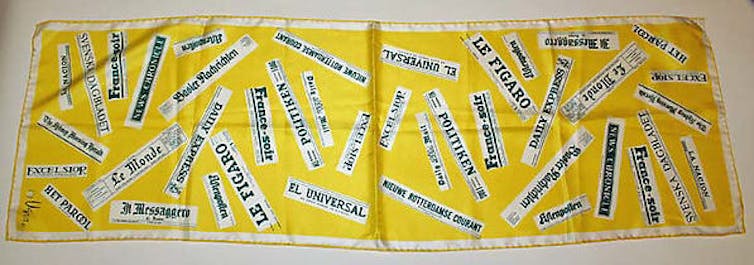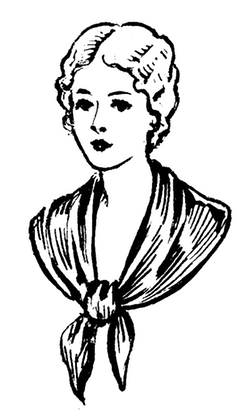-
-
-
Tổng tiền thanh toán:
-
How Silk?
Một chiếc khăn lụa có thể có vô vàn ý nghĩa- nhưng trên tất cả, đó là Uy tín

Khi Giám đốc Quỹ tiền tệ Thế giới Christine Lagard tới dự Hội nghị thượng đỉnh G8 vào tháng Sáu, khả năng cao là bà ấy sẽ đeo một chiếc khăn lụa- một món phụ kiện thời trang nổi tiếng mà bà nổi tiếng hay sử dụng, và cũng là món phụ kiện ngày càng dành được nhiều sự chú ý. Trên thực tế, đài BBC gần đây đã nhận định rằng Những chiếc khăn lụa đã trở thành "một biểu tượng quyền lực mới" của phụ nữ.
Cũng phải thôi, tượng tự như khi đàn ông
True, just as some men choose amusing neckties to enliven monochrome suits, many women who work in an atmosphere that requires conservative business apparel will wear scarves to add a fillip of color and distinction.
But the trend is anything but “new.” In looking at the history of scarves in the 19th and 20th centuries, it’s clear that the allure and power of scarves has always existed – and persists.
A single piece of cloth
|
The scarf is the most simple form of adornment: a single piece of cloth. For this reason, it’s one of the most versatile clothing accessories, used for centuries across a variety of cultures, for a range of purposes. Many Muslim women wear headscarves for modesty, while ladies of a certain age favor scarves with a triangular fold to protect expensive or elaborate coifs. A scarf can be a political statement, and can denote a wearer’s affiliation or beliefs. Early 20th-century crusaders for women’s rights used their clothing to promote their cause, wearing scarves in the movement’s colors: white, green and purple. During World War II, scarves expressed nationalist sentiments. The British firm Jacqmar produced designs with propaganda-themed slogans. One featured the phrase “Shoulder to Shoulder” on a map of England emblazoned with British and American symbols. Another design mimicked a wall covered with posters urging citizens to “Lend to Defend” and “Save for Victory.” |
Votes for Women: the scarf as a political statement. © Victoria and Albert Museum, London. |
An elegant fashion
|
But in Western culture, the scarf is most prominently known for its use as a fashion accessory, one that first gained widespread popularity in the 19th century. The fichu is a typical 18th- and 19th-century style that can be seen as the forerunner of modern scarves. A piece of fabric worn lightly draped on the upper chest and usually knotted in front, it provided modest covering but was also an opportunity to add an especially fine textile – sometimes lace edged or embroidered – to an ensemble. Lightweight, finely woven silk and cashmere shawls from India were one of the first fashionable scarf styles. Empress Joséphine – the first wife of Napoleon – had an extensive collection (thanks to her husband’s travels), and the style persisted through much of the 19th century, spawning cheaper imitations fabricated in other parts of Europe, notably France and Paisley, Scotland. |
The fichu was a predecessor to the scarf.Wikimedia Commons |
Status symbols
Like much of high fashion, scarves can signal one’s status, and limited edition scarves – often only made available to favored customers – can act as specific indicators for those in the know.
For example, fashion houses send scarves, often during the holidays, as thank-yous to loyal clients. Those produced by Parisian couturiers during the 1950s were especially chic, often designed with sketches of the maison; others displayed printed patterns in the whimsical, painterly style of the era.
The House of Dior would present scarves to its regular customers as a token of gratitude. © 2000–2015 The Metropolitan Museum of Art. Gift of Mrs. Michael Blankfort, in memory of her mother, Mrs. William Constable Breed, 1976
And from the 1950s into the 1970s, the famed Manhattan eating and drinking establishment 21 produced a series of annual scarves and sent them to favorite “regulars.”
The restaurant’s owners commissioned well-known designers, and each year’s scarf design referred to some aspect of the restaurant – its famous façade, the collection of jockey statues outside or the number 21.
Actress Lauren Bacall, an esteemed regular, donated her 21 scarves to the Museum at New York’s Fashion Institute of Technology, where other pieces from her wardrobe were recently exhibited.
A canvas for experimentation
As a discrete space, a scarf presents an opportunity for experimentation often not available in other realms of dress that are determined – and restricted – by the shape of the body.
In London in the 1940s, Lida and Zika Ascher initiated their “Artist Squares” project, enlisting an international roster of prominent artists to design large scarves, a group that included Henri Matisse, Jean Cocteau and Henry Moore.
The Artist Squares were sold in major department stores and also exhibited – framed, like paintings – at London’s Lefevre Gallery.
To celebrate her new couture salon in 1935, the designer Elsa Schiaparelli made a collage of her press clippings and had it printed as fabric for scarves and other accessories, turning black and white type into a striking motif.
A scarf by the American designer Vera offers another variation on lettering as ornament, presenting the titles of international newspapers, each in its distinctive typeface, on a vivid yellow background.

A scarf by Vera, featuring newspaper typeface. © 2000–2015 The Metropolitan Museum of Art. Gift of Heather B. Babb, 1996
Hermès: The crème de la crème
Certain labels are particularly associated with high style in scarves. Ferragamo, Fendi and Gucci – all originally esteemed leather goods houses – now produce desirable scarves.
But for prestige and polish, Hermès represents the pinnacle of scarf culture. Several aspects of its business have contributed to the company’s reputation. Founded in 1837 as a supplier of equestrian supplies, Hermès began offering scarves, called carrés, in 1937.
Their focus on exclusivity has encouraged an almost fetishistic loyalty among customers, many of whom could more properly be termed “collectors.” Limiting the number of designs they offer each season has maintained Hermès’ mystique. The company’s focus on craftsmanship helps justify their reputation and high prices; Hermès takes pride in the impressive number of colors in each design, the hand-printing process and the fineness of their silk, positioning their output as artisanal creations.
A man demonstrates the intricate screen printing process of a Hermès scarf.
While not at the level of Hermès, the American accessories company Echo, founded in 1923, also has a loyal following. The firm pinpointed the essence of the scarf with their memorable ad campaign “The Echo of an Interesting Woman,” introduced in the 1970s.
In contemporary fashion, scarves continue to serve the same functions as those earlier fine linen fichus and paisley shawls; they denote connoisseurship and sophistication.
It’s no surprise, then, that sociologist and image consultant Anna Akbari makes “Put on a scarf” the first entry on her current list of “5 Simple Ways To Hack Your Image,” recognizing their potential for instant uplift and an infusion of individuality.
Source: theconversation.com
Editted by DK SANSAN & GISY Team
---
Like what you just read? If you want to read more articles like this, please join our mailing list:
Lỗi liquid: Không thể biến đổi String thành input có kiểu String
Lỗi liquid: Không thể biến đổi String thành input có kiểu String



